
Our First Four (U.K. Version)
(Update: 31th. December 2018)

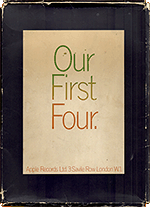 Apple Original Sleeve |
|
|
| "Our First Four"
Advertisement / "New Musical Express"
31th August 1968 --> Click! |
||
 |
On 26 August 1968, Apple
Records released their first four singles: including tracks by The Beatles, Mary Hopkin, Jackie Lomax and Black Dyke Mills Band. The idea for The Beatles’ Apple Corps began to take shape following the death of their manager Brian Epstein; their newly formed company’s first project was the film, Magical Mystery Tour. Apple Records was officially founded The Beatles return from India in 1968. The Beatles were contracted to EMI’s Parlophone label in the UK and Capitol Records in America and they struck a new distribution deal with the two companies to distribute Apple Records’ releases. Beatles recordings issued in the UK on Apple had Parlophone catalogue numbers, while US issues had Capitol catalogue numbers. The first four 7" releases of Apple Records boxed and sent out to radiostations etc. as promotional package / Cardboard Box. An advertisement in the British press on 31 August 1968 was similarly structured and consisted of the biographies in the press folder in the promotional package. |
|
| On
26 August 1968 Apple released four singles in the UK. There
was the Beatles, ‘Hey Jude’ backed by ‘Revolution’, with its
Parlophone number, but the now familiar Apple record centre.
Apple 2 was Mary Hopkin’s ‘Those were the Days’, produced by
Paul McCartney. Apple 3 was Jackie Lomax’s ‘Sour Milk Sea’,
a song written and produced by George Harrison and Apple 4
was ‘Thingumybob’ by the Black Dyke Mills Band. This was a
Lennon and McCartney instrumental that was the theme to a
Yorkshire Television sitcom of the same name starring
Stanley Holloway. ‘Hey Jude’ topped the UK singles chart for two weeks from 11 September and was replaced at No.1 by Mary Hopkin’s ‘Those Were The Days’ that stayed at No.1 for six weeks from 25 September. No other record company has had such conspicuous success with it’s first two releases. Neither of the other releases charted. Apple 1 was a one-off pressing of Frank Sinatra singing ‘Maureen Is a Champ’ (with lyrics by Sammy Cahn) to the melody of ‘The Lady Is a Tramp’ for Ringo Starr‘s then-wife Maureen as a surprise gift for her 21st birthday. Apple Records went on to sign James Taylor, Billy Preston, the Modern Jazz Quartet, the Iveys (who later became Badfinger) and Doris Troy. |
|
|
Our First Four |
||||
|
RELEASE DATE
|
26th. August 1968 / Promotional
Use Only |
||||
| PAPER /
CARDBOAD BOX |
|||||
| BOX: FRONT | BOX: BACK | BOX OPENED --> Click! |
|||
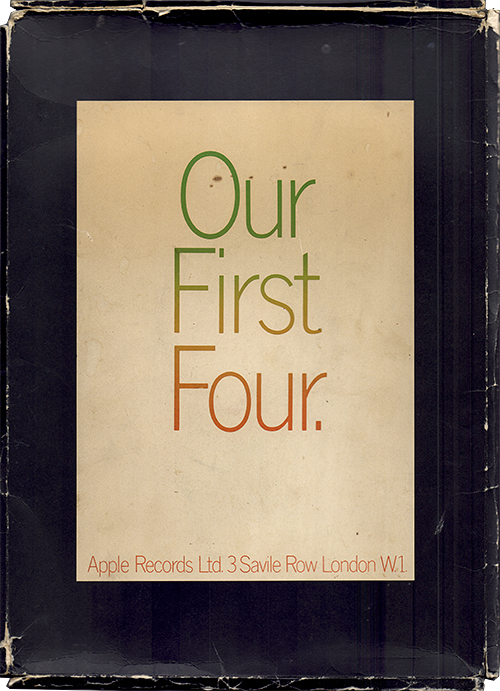 |
 |
 |
|||
| BOX: FRONT CLOSE UP | BOX: BACK CLOSE UP | ||||
 |
 |
Original UK release promo-only "Our First Four" box-set with its thin paper/cardboard box. | |||
| Apple Records address "3 Savile Row London W1"
was printed at the bottom of the front of the box. |
|||||
| FOLDER 1 (GREEN): THE
BEATLES |
|||||
 |
 |
Each single was accompanied by a press
release written by Derek Taylor printed on the outside of a
coloured folder containing an artist photo and a plastic
sleeve to hold the record. |
|||
|
FOLDER
CLOSE UP
|
|||||
 |
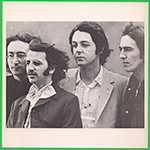 |
On 30th. August 1968 Apple released four singles in the UK. There was the Beatles, ‘Hey Jude’ backed by ‘Revolution’, with its Parlophone number. | |||
| LABEL CLOSE UP --> Click! |
|||||
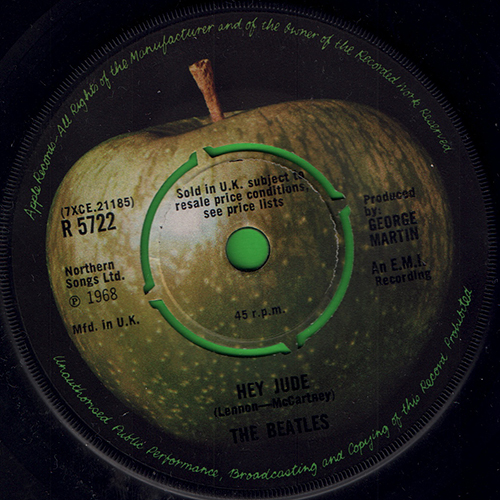 |
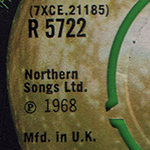 |
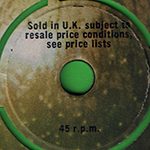 |
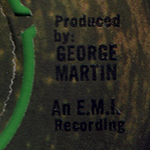 |
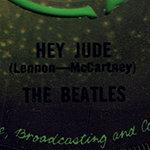 |
|
| TITLE | SIDE 1 | Hey
Jude (Lennon - McCartney) |
|||
| SIDE 2 | Revolution (Lennon - McCartney) | ||||
| CATALOG NUMBER | R 5722 |
LABEL | Dark Green Apple
Label |
||
| MIX |
Mono |
VINYL
COLOR |
Black |
||
| MATRIX No. | SIDE
1 |
7XCE
21185 -1 |
|||
| SIDE
2 |
7XCE
21186 -1 |
||||
| RECORD COMPANY'S NAME | Apple
Records + An E.M.I. Recording |
||||
| CENTER | Push-Out Center |
CENTRAL REMARK "SOLD
IN U.K..."
|
Yes |
||
| PUBLISHER'S NAME | SIDE 1 | Northern
Songs Ltd. |
|||
| SIDE 2 | Northern
Songs Ltd. |
||||
| PRODUCER | George
Martin |
||||
| COMMENTS | Hey Jude, with Revolution on the b-side, was also the group's first on their Apple label. The single was issued as Apple R 5722, although the catalogue number followed Parlophone's convention, and the rights remained with the EMI subsidiary. | ||||
| FOLDER
2 (ORANGE): Mary Hopkin |
|||||
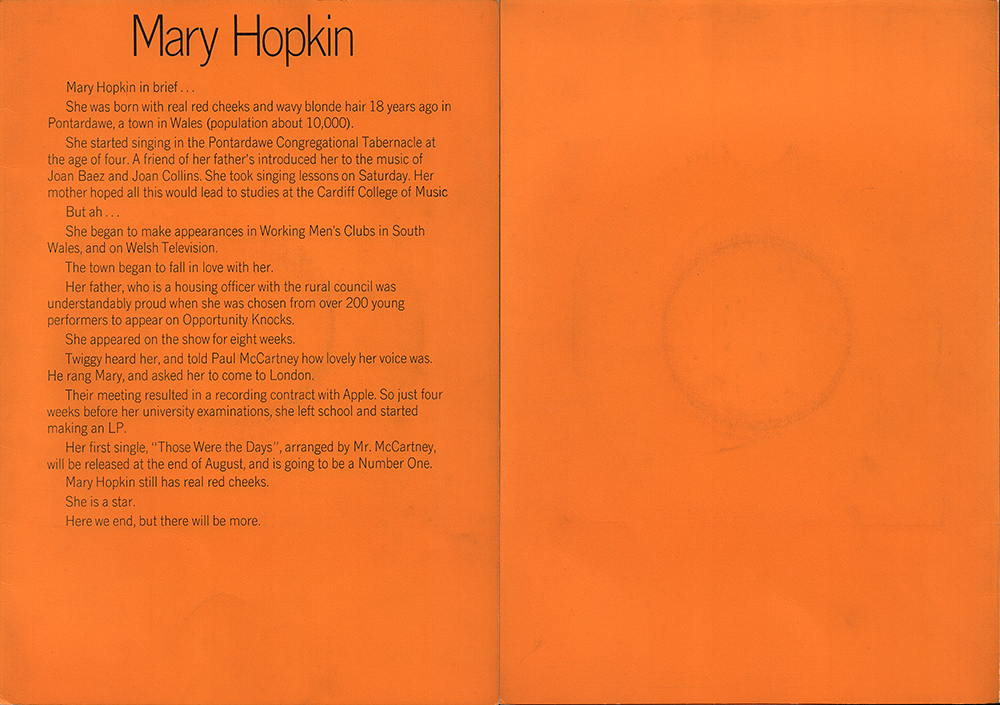 |
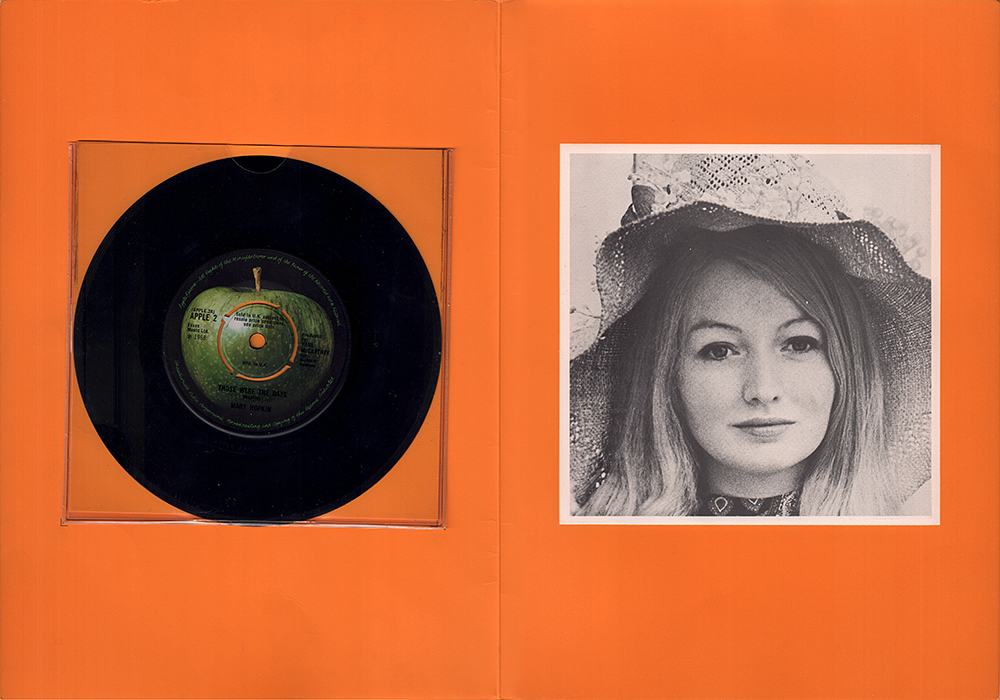 |
Each
single was accompanied by a press release written by Derek
Taylor printed on the outside of a coloured folder
containing an artist photo and a plastic sleeve to hold the
record. |
|||
|
FOLDER
CLOSE UP
|
|||||
 |
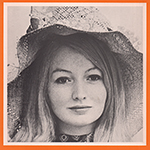 |
Apple 2 was Mary Hopkin’s
‘Those were the Days’, produced by Paul McCartney. |
|||
 |
 |
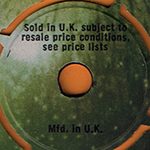 |
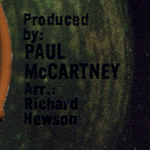 |
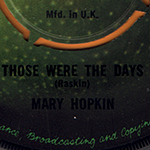 |
|
| TITLE | SIDE 1 | Those
Were The Days (Raskin) |
|||
| SIDE 2 | Turn
Turn Turn (Seeger) |
||||
| CATALOG NUMBER | APPLE 2 |
LABEL | Dark Green Apple
Label |
||
| MIX |
Mono |
VINYL
COLOR |
Black |
||
| MATRIX No. | SIDE
1 |
1002 A-1
APPLE 2 A-1 |
|||
| SIDE
2 |
1002 B-1
APPLE 2 B-1 |
||||
| RECORD COMPANY'S NAME | Apple
Records |
||||
| CENTER | Push-Out Center |
CENTRAL REMARK "SOLD
IN U.K..."
|
Yes |
||
| PUBLISHER'S NAME | SIDE 1 | Essex
Music Ltd. |
|||
| SIDE 2 | Essex
Music Ltd. |
||||
| PRODUCER | SIDE 1 | Produced
by: Paul McCartney Arr: Rechard Hewson |
|||
| SIDE 2 | Produced by: Paul McCartney | ||||
| COMMENTS | Mary
Hopkin is a Welsh folk singer best known for her 1968 UK
number one single "Those Were the Days". She was one of the
first musicians to sign to the Beatles' Apple label. "Those Were The Days" is Mary Hopkin's 1968 version of the song, produced by Paul McCartney, became a number one hit on the UK Singles Chart. The song also reached number two on the Billboard Hot 100, behind McCartney's own band The Beatles' hit "Hey Jude". |
||||
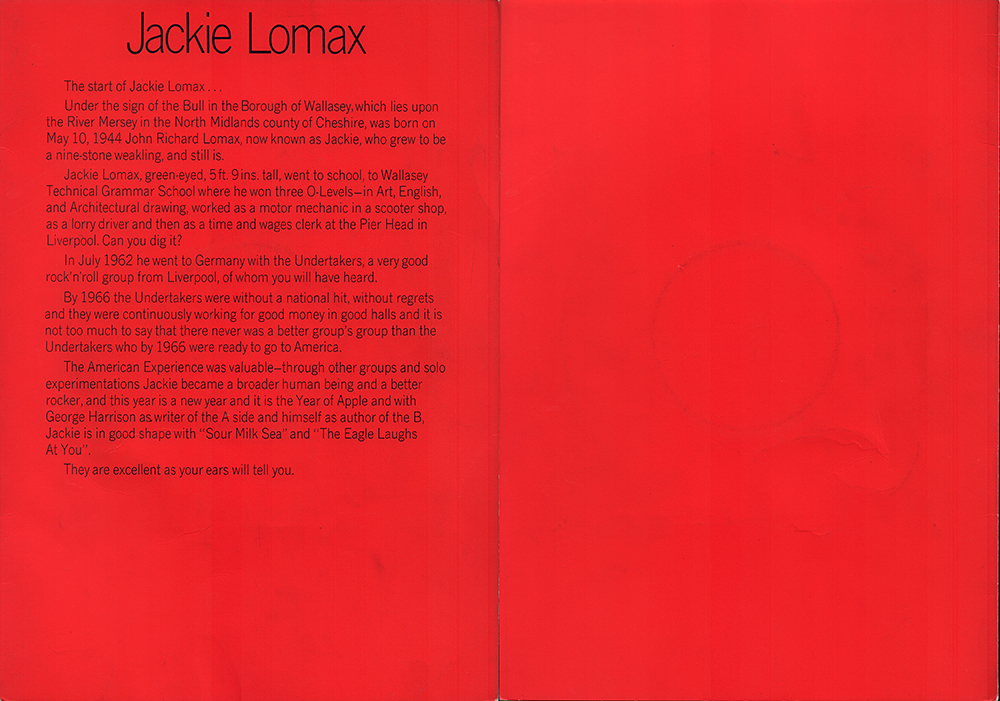 |
 |
Each single was
accompanied by a press release written by Derek Taylor
printed on the outside of a coloured folder containing an
artist photo and a plastic sleeve to hold the record. |
|||
|
FOLDER
CLOSE UP
|
|||||
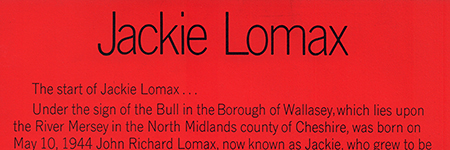 |
 |
Apple 3 was Jackie Lomax’s
‘Sour Milk Sea’, a song written and produced by George
Harrison. |
|||
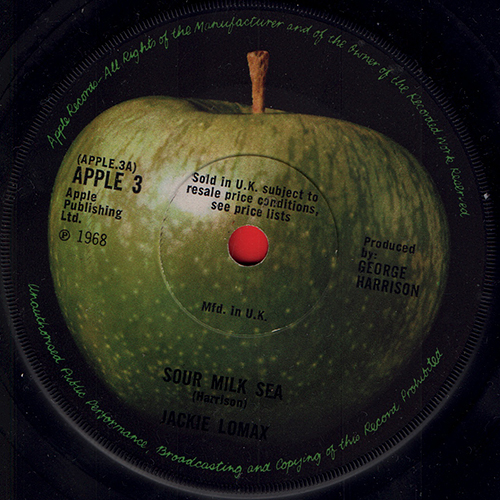 |
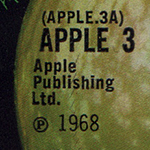 |
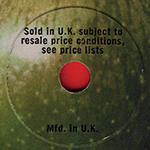 |
 |
 |
|
| TITLE | SIDE 1 | Sour
Milk Sea (Harrison) |
|||
| SIDE 2 | The
Eagle Laughs At You (Lomax) |
||||
| CATALOG NUMBER | APPLE 3 |
LABEL | Dark Green Apple
Label |
||
| MIX |
Mono |
VINYL
COLOR |
Black |
||
| MATRIX No. | SIDE
1 |
1001 A-1
APPLE 3A-1 |
|||
| SIDE
2 |
1001 A-1
APPLE 3B-1 |
||||
| RECORD COMPANY'S NAME | Apple
Records |
||||
| CENTER | Solid Center |
CENTRAL REMARK "SOLD
IN U.K..."
|
Yes |
||
| PUBLISHER'S NAME | SIDE 1 | Apple
Publishing Ltd. |
|||
| SIDE 2 | Apple Publishing Ltd. | ||||
| PRODUCER | Produced
by: George Harrison |
||||
| COMMENTS | John
Richard Lomax was an English guitarist and
singer-songwriter. He is best known for his association with
George Harrison, who produced Lomax's recordings for the
Beatles' Apple record label in the late 1960s. The Beatles' new record label, Apple Records, took over responsibility for Lomax's recording career, and George Harrison became involved in production. Despite having three-quarters of The Beatles on the record, plus Eric Clapton and Nicky Hopkins, Lomax's 1968 debut single on Apple, the Harrison-penned "Sour Milk Sea", backed with "The Eagle Laughs at You" written by Lomax. |
||||
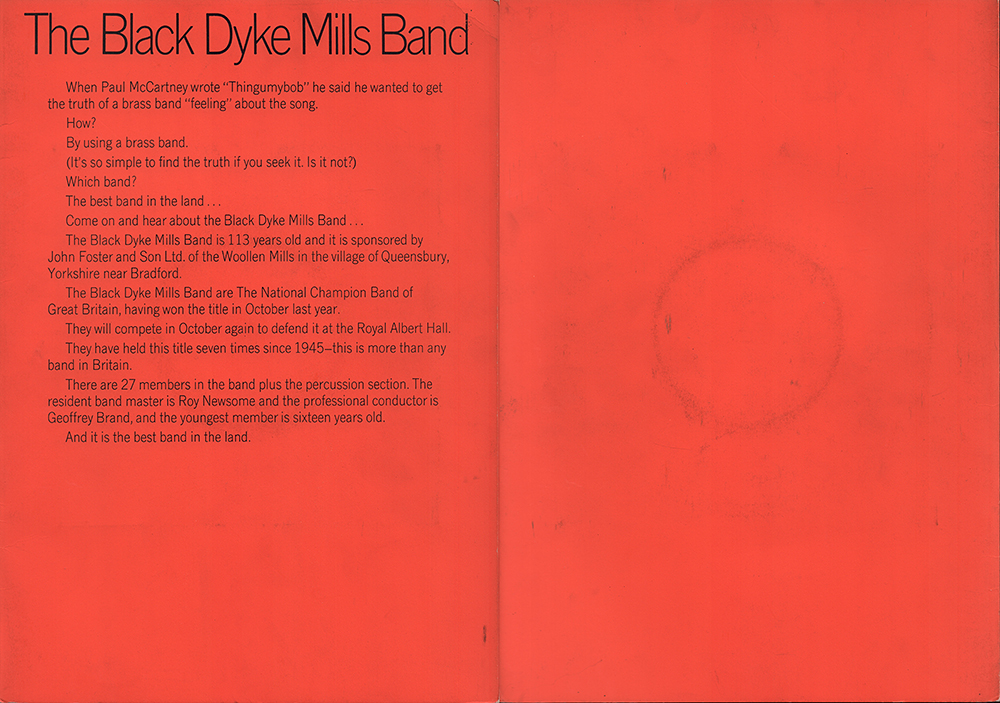 |
 |
Each single was
accompanied by a press release written by Derek Taylor
printed on the outside of a coloured folder containing an
artist photo and a plastic sleeve to hold the record. |
|||
| FOLDER CLOSE UP | |||||
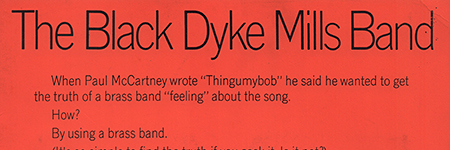 |
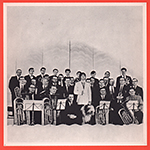 |
Apple 4 was ‘Thingumybob’
by the Black Dyke Mills Band. This was a Lennon and
McCartney instrumental that was the theme to a Yorkshire
Television sitcom of the same name starring Stanley
Holloway. |
|||
| LABEL CLOSE UP --> Click! |
|||||
 |
 |
 |
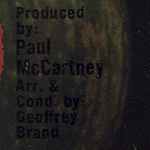 |
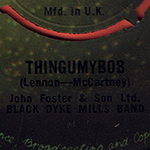 |
|
| TITLE | SIDE 1 | Thingumybob
(Lennon - McCartney) John Foster & Son Ltd. |
|||
| SIDE 2 | Yellow Submarine (Lennon - McCartney) John Foster & Son Ltd. | ||||
| CATALOG NUMBER | APPLE 4 |
LABEL | Dark Green Apple
Label |
||
| MIX |
Mono |
VINYL
COLOR |
Black |
||
| MATRIX No. | SIDE
1 |
1003 A-1
APPLE 4A-1 |
|||
| SIDE
2 |
1003 B-1 APPLE 4B-1 | ||||
| RECORD COMPANY'S NAME | Apple
Records |
||||
| CENTER | Push-Out Center |
CENTRAL REMARK "SOLD
IN U.K..."
|
Yes |
||
| PUBLISHER'S NAME | SIDE 1 | Northern
Songs Ltd. |
|||
| SIDE 2 | Northern
Songs Ltd. |
||||
| PRODUCER | Produced
by: Paul McCartney Arr. & Cond. by: Geoffrey
Brand |
||||
| COMMENTS | The
Black Dyke Mills Band, a brass band from Yorkshire, England,
was one of Apple Records' first signings. On 30th. June
1968, Paul McCartney recorded them performing the
Lennon-McCartney composition Thingumybob, which became their
first single for the label. The recording took place in Saltaire near Bradford, with McCartney producing the session. As well as Thingumybob, the group recorded Yellow Submarine for the single's b-side. Thingumybob was written as the theme tune to the Yorkshire Television comedy of the same name, which was transmitted from August 1968. The single, credited to John Foster & Sons Ltd Black Dyke Mills Band, was released as Apple 1800 in the US on 26 August, and in the UK as Apple 4 on 6 September. |
||||
|
OTHER ITEM
|
|||||
|
-
|
|||||
|
COMMENTS
|
Their very first
releases were marked by the issuing of a limited edition
press kit of the first four 45rpm vinyl singles to come out
on Apple – which they called “Our First Four”. In the UK there seems to have been two versions of this: One was in a stronger, hard plastic outer case. Examples of this version were very limited, and these were hand-delivered to dignitaries like Stanley Gortikov, President of Capitol Records in 1968; to Her Majesty the Queen at Buckingham Palace; to her sister Princess Margaret at Kensington Palace; to the Queen Mother at St James’s Palace; and to the then British Prime Minister Harold Wilson at Number 10 Downing Street, London. The other, lower cost version was posted to radio disc jockeys, music journalists and critics. It was in a cheaper, thin black cardboard box. Was released in 1968 to commemorate the launch of the APPLE label. It was manufactured in an extremely limited amount of copies. Both versions contained four singles: The Beatles “Hey Jude/Revolution” (R 5722); Mary Hopkin “Those Were the Days”(APPLE 2); Jackie Lomax “Sour Milk Sea” (APPLE 3); The Black Dyke Mills Band “Thingumybob” (APPLE 4). Each of the records have push-out or solid centres and the overprint "Sold in U.K. subject to resale price conditions, see price lists" on the record centres. This identifies them to be very first issues. Each single was accompanied by a press release written by Derek Taylor printed on the outside of a coloured folder containing an artist photo and a plastic sleeve to hold the record. In the USA, the set was designed in a somewhat more complex manner. The white binder included the photos, biographies and four booklets with four sheets carrying further information about the records. |
||||